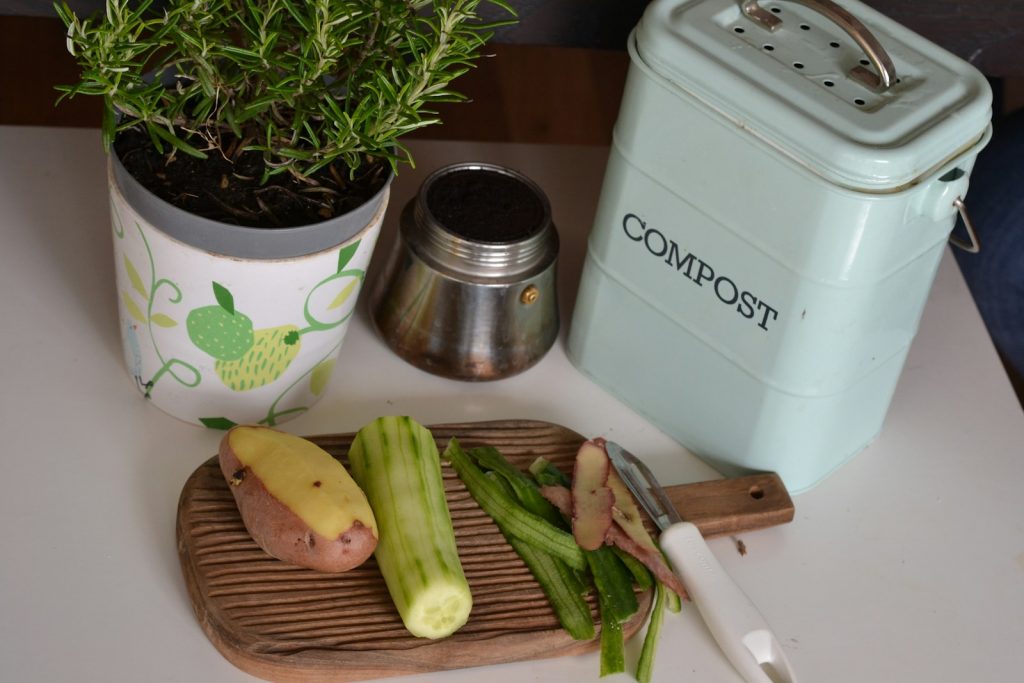Tired of seeing your kitchen bin overflow? You’re not alone. Kitchens are often a major source of household waste, from single-use packaging to food scraps. But the good news is that making a significant dent in your kitchen waste doesn’t require a massive overhaul. With a few simple eco friendly kitchen swaps, you can drastically reduce your environmental footprint, save money, and create a healthier home.
These changes are all about replacing disposable, single-use items with reusable, sustainable alternatives. Ready to make a difference? Here are 15 easy swaps you can implement in your kitchen starting today!
(And for a complete overview of creating a greener kitchen, don’t forget to check out our main guide: “The Ultimate Guide to an Eco-Friendly Kitchen (for Beginners & Families)“.)
Easy Swaps for a Low-Waste Kitchen:
- Swap Plastic Shopping Bags for Reusable Tote Bags: This is a classic for a reason! Keep a stash of reusable tote bags in your car, purse, or by the door so you’re always prepared for a grocery run.
- Impact: Reduces plastic pollution and the demand for single-use plastic bags.
- Swap Disposable Produce Bags for Reusable Mesh Bags: Those flimsy plastic bags for fruits and veggies add up. Reusable mesh produce bags are lightweight, washable, and allow cashiers to easily see what’s inside.
- Impact: Cuts down on another significant source of single-use plastic.
- Swap Cling Film for Beeswax Wraps or Silicone Lids: Plastic cling film is hard to recycle and often ends up in landfills. Beeswax wraps are a natural, reusable alternative for covering bowls and wrapping food. Silicone stretch lids are another great option.
- Impact: Eliminates plastic wrap waste and potential chemical leaching into food. (You can even learn to make your own with our upcoming guide: “DIY Reusable Food Wraps: A Simple Eco Kitchen Project”!)
- Swap Disposable Paper Towels for Cloth Napkins & Reusable Kitchen Towels: While paper towels seem convenient, they create a lot of waste. Switch to cloth napkins for meals and use washable microfiber cloths or cotton dish towels for spills and cleaning.
- Impact: Reduces paper waste and saves trees.
- Swap Single-Use Coffee Pods for a Reusable Coffee Filter or French Press/Moka Pot: Those individual coffee pods are a huge source of waste. Opt for a reusable filter for your existing machine, or switch to brewing methods like a French press, Moka pot, or pour-over that use loose coffee grounds.
- Impact: Drastically cuts down on plastic and aluminum pod waste.
- Swap Plastic Water Bottles for a Reusable Water Bottle: Investing in a durable, reusable water bottle for each family member is an easy win for reducing plastic waste and saving money.
- Impact: Reduces plastic bottle pollution and the energy used to produce them.
- Swap Disposable Straws for Reusable Straws (or Go Straw-Free!): If you use straws, switch to reusable options made from stainless steel, glass, bamboo, or silicone. Better yet, skip the straw altogether when possible.
- Impact: Helps protect marine life from plastic straw pollution.
- Swap Plastic Food Storage Containers for Glass or Stainless Steel: While plastic containers are common, glass and stainless steel options are more durable, don’t leach chemicals into food, and last longer.
- Impact: Reduces plastic use and exposure to potentially harmful chemicals.
- Swap Pre-Packaged Snacks for Bulk Bin Purchases: Buying snacks like nuts, seeds, grains, and dried fruit from bulk bins (using your own reusable bags or containers) significantly reduces packaging waste.
- Impact: Minimizes single-use packaging and often saves money.
- Swap Tea Bags (often containing plastic) for Loose Leaf Tea & a Reusable Infuser: Many tea bags are sealed with polypropylene plastic. Loose leaf tea brewed in a reusable infuser, tea ball, or teapot offers a plastic-free and often higher-quality tea experience.
- Impact: Avoids microplastic consumption and reduces waste.
- Swap Disposable Dish Sponges for Compostable or Washable Alternatives: Traditional plastic sponges shed microplastics and end up in landfills. Opt for natural cellulose sponges, loofahs, coconut coir scrubbers (which can be composted), or washable dishcloths.
- Impact: Reduces plastic waste and microplastic pollution.
- Swap Bottled Condiments (when possible) for Homemade or Bulk Options: Things like salad dressings, sauces, and even ketchup can often be made at home with simple ingredients, reducing packaging. Some stores also offer condiments in bulk.
- Impact: Cuts down on glass and plastic bottle waste.
- Swap Plastic Ziploc Bags for Reusable Silicone Bags or Containers: For food storage and packing lunches, reusable silicone bags are a fantastic, durable alternative to single-use plastic bags.
- Impact: Significantly reduces single-use plastic bag waste.
- Swap Disposable Baking Liners for Silicone Baking Mats or Greasing/Flouring: Instead of single-use parchment paper or cupcake liners, use reusable silicone baking mats or simply grease and flour your pans.
- Impact: Reduces paper waste from baking.
- Swap Store-Bought Cleaning Sprays for DIY Natural Cleaners in Reusable Bottles: Many commercial cleaners come in single-use plastic bottles and contain harsh chemicals. You can easily make your own effective cleaners using ingredients like vinegar and baking soda, stored in a reusable spray bottle.
- Impact: Reduces plastic bottle waste and exposure to harsh chemicals. (Find recipes in our upcoming guide: “DIY Natural Kitchen Cleaners: Effective & Eco-Friendly Recipes”).


